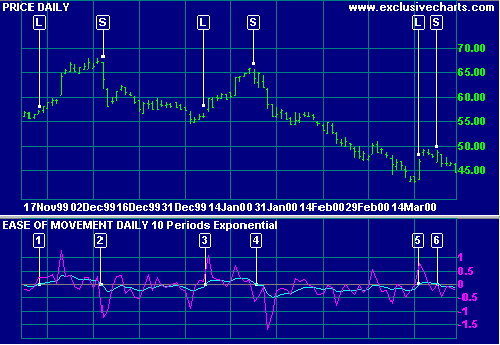Ease of Movement Indicator
Ease of Movement was developed by Richard W Arms and performs a similar function to Equivolume charts. It highlights the relationship between volume and price changes and is particularly useful for assessing the strength of a trend.
The indicator shows:
- high positive values when prices move upward on light volume;
- high negative values when prices move down on light volume;
- low values if price is not moving or if it takes heavy volume to move prices, signaling distribution or accumulation.
Ease of Movement Trading Signals
Signals are normally taken from an exponential moving average plotted on the Ease of Movement indicator. They are more effective in a trending market.
- Go long when Ease of Movement crosses to above zero (from below).
- Go short when Ease of Movement crosses to below zero (from above).
Example
Coca Cola Corporation plotted with
Ease of Movement indicator smoothed by a
10 day exponential moving average.

Mouse over chart captions to display trading signals.
- Go long [L]: Ease of Movement crosses to above zero.
- Go short [S]: Ease of Movement crosses to below zero.
- Go long [L]: Ease of Movement crosses to above zero.
- Go short [S]: Ease of Movement crosses to below zero.
- Go long [L]: Ease of Movement crosses to above zero.
- Go short [S]: Note that we are whipsawed more frequently in a ranging market.
Setup
The Ease of Movement default is set at 10 days smoothing by an exponential moving average. To alter the default settings - Edit Indicator Settings.
See Indicator Panel for directions on how to set up an indicator.
Ease of Movement Formula
The steps in calculating Ease of Movement are:
- Calculate the Mid-point for each day:
(High + Low) / 2 - Calculate the Mid-point Move for each day:
Mid-point [today] - Mid-point [yesterday] - The Box Ratio determines the ratio between height and width of the
Equivolume box:
Volume [in millions] / (High - Low) - Ease of Movement is then calculated as:
Mid-point Move / Box Ratio - Ease of Movement is normally smoothed with a 14 day exponential moving average.

Author: Colin Twiggs is a former investment banker with almost 40 years of experience in financial markets. He co-founded Incredible Charts and writes the popular Trading Diary and Patient Investor newsletters.
Using a top-down approach, Colin identifies key macro trends in the global economy before evaluating selected opportunities using a combination of fundamental and technical analysis.
Focusing on interest rates and financial market liquidity as primary drivers of the economic cycle, he warned of the 2008/2009 and 2020 bear markets well ahead of actual events.
He founded PVT Capital (AFSL No. 546090) in May 2023, which offers investment strategy and advice to wholesale clients.
